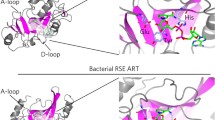Abstract.
Poly(ADP-ribose) glycohydrolase (PARG) is a catabolic enzyme that cleaves ADP-ribose polymers formed by members of the PARP family of enzymes. Despite its discovery and subsequent partial purification in the 1970s [1–3] and the cloning of its single gene in the late 1990s [4], little is known about the role of PARG in cell function. Because of its low abundance within cells and its extreme sensitivity to proteases, PARG has been difficult to study. The existence of several PARG isoforms with different subcellular localizations is still debated today after more than 30 years of intensive research. In this article, we want to summarize and discuss the current knowledge related to PARG, its different forms and subcellular distribution. We also examine the possible biological roles of PARG in modulating chromatin structure, transcription, DNA repair and apoptosis.
Similar content being viewed by others
Author information
Authors and Affiliations
Corresponding author
Rights and permissions
About this article
Cite this article
Bonicalzi, ME., Haince, JF., Droit, A. et al. Poly-ADP-ribosylation in health and disease. CMLS, Cell. Mol. Life Sci. 62, 739–750 (2005). https://doi.org/10.1007/s00018-004-4505-1
Issue Date:
DOI: https://doi.org/10.1007/s00018-004-4505-1




